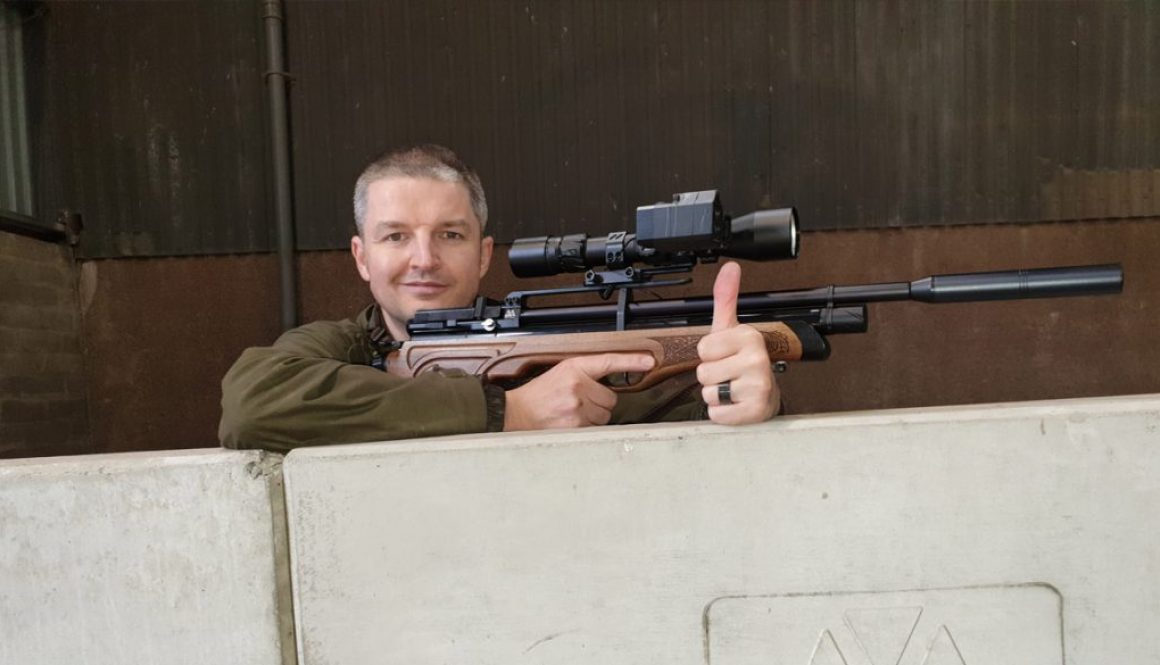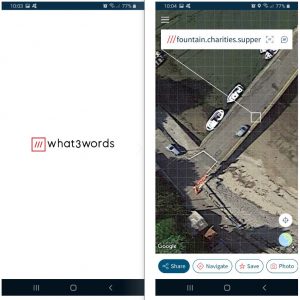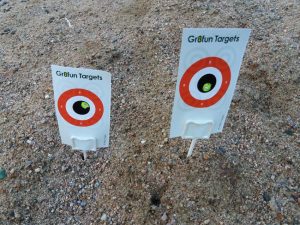Making the Most of your Permission
Written by our guest blogger, Russ Douglas.
So I have a Permission, how do you make best use of it, and avoid pitfalls?
Check the weather and plan accordingly
When I’m planning a visit to a Permission, I check local weather there via the BBC App. This lets me know not only if the winds are low enough for safe Air rifle shooting, but also the prevailing direction. Sometimes that knowledge changes the Permission I’ll visit, or at least the fields I’ll target or the gateway I’ll park in / direction of approach. You always want the wind in your face when out hunting, as this prevents your scent from reaching your prey, plus reduces the distance your sounds travel. Stealth is everything when targeting prey already constantly alert for their natural predators.
Speaking of useful Apps, if out solo you should always let someone know where you’re going, and agree to check-in periodically, kind of like a hunter’s version of a ‘safe call’. If you do get into difficulty there’s a clever App that lets you identify wherever you are on the planet via three words. Using What3words you can message anyone with the same App, so they know exactly where to send help. This can also help you communicate to the landowner any issues you observe, such as a broken fence, animal in difficulty or suspicious activity. https://what3words.com/ A fantastic global facility, very clever indeed.
Preparation, aim for efficiency
That brings me onto preparation (AKA “the eight P’s”: Proper prep plus planning prevents pi55-poor performance 🙂), think of everything you’re wearing and carrying. Don’t be spraying on your best deodorant, Roger rabbit will thank you as he smells you a mile off and legs it. Ideally, wear well-worn clothes as they’re naturally softer and quieter, plus wash them in eco detergents, which will reduce the UV brightness of the fabric patterns. As you dress for hunting get into a routine of always storing your hat, face veil, gloves, headtorch, spare batteries, knife and rubber gloves -in the same place. I put essentials in my smock’s ‘joey pouch’ (chest pocket). Familiarity aids memory so you’ll always know where everything is when you need it.
Such preparedness is especially essential for me (being disabled), to avoid leaving something in the car. Simply having to take a trek there and back mid-hunt can ruin an outing if it leaves me more tired / sore. I aim for efficiency of movement to make the most of each trip. This leads me onto knowing when to call it a day. Maybe if I resist walking ‘that little bit further to check the next paddock’, I’ll be less achey the next day and will be able to recover faster and return sooner for another session. This is often difficult to do whether you’re on a roll having a successful night, or pickings are scarce and you don’t want to head home empty-handed.
A boon here (when you are having success) is a secure leak-proof shoulder game bag to carry your prey. Shot rabbits get very heavy very quickly, so a leak-proof bag is a great asset to tote them around. Better still if you use a field knife to paunch them in field to further reduce the weight, as providing it’s not excessive nature won’t leave the waste for long.
I usually take a test shot or two at a small target at reasonable range when I first arrive at my Permission, to check everything’s still on zero. I have occasionally skipped this step, e.g. on two occasions when parking in a farm driveway and a Rabbit and unusually careless Crow presented themselves. This just reminds us you should be constantly aware and prepared to quietly get straight into action, should the opportunity present.
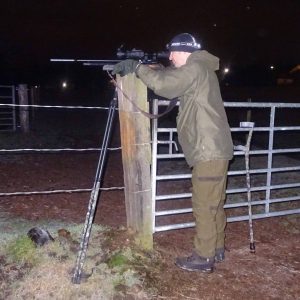
Use available cover to brace against
Make use of your surroundings
While out shooting offhand (standing unsupported) is most shaky, so I try to traverse my Permissions via fixed landmarks like trees, fenceposts or walls. This has the dual advantage of giving me a stable shooting position to lean against if braced against a wall, tractor or tree; plus leaves me less silhouetted (e.g. against the skyline, or in moonlit conditions).
If no gun rests – Trigger sticks
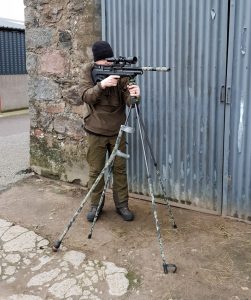
Essential Trigger Sticks
Where there’s no convenient object to rest against, I always have my Primos Trigger Sticks with me. Weighing just 1.35Kg these are light enough to use constantly as an impromptu left crutch, then when carefully/quietly opened out -make a nice stable shooting platform. The trigger smoothly adjusts the height, while using the rubberised V-rest on top to hold the rifle securely. I improved mine by spiral-wrapping the hollow legs with self-sticking adhesive-free camo tape, to reduce any noise if the hollow legs bang against each other or against my shooting seat.
Speaking of seats, being disabled I’ve annoyingly found I can’t walk, stand or sit for too long without discomfort. One way round this is a bucket shooting seat with a rotating seat/lid. This isn’t as comfortable as a game bag for carrying rabbits (so I use a second-hand repurposed golf trolley for that), but lets me sit in relative comfort while staking-out a warren or paddock problem area. I later improved-upon this by upgrading to an extra-tall bucket shooting seat, as my troublesome back complained the first one was too low.
One potential hazard when using Night Vision (NV) gear is getting ‘stink eye’, where a too-bright spotter eyepiece steals-away some of your night vision. E.g. when I’m hunting rats in total darkness, spotting them with a thermal spotter then swapping devices to target them with an NV scope. One option is to turn down the device’s brightness, usually via the menu settings. Another remedy is to buy cheap 37mm coloured camera filters (e.g. from ebay). Slipping on of these into the corrugated rubber eyecup of your scope can reduce the glare, helping you see when not looking through the scope.
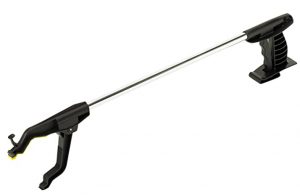
Safety first, especially when handling rats
Safety first when recovering prey
Remember rats can carry Weil’s disease, so take no chances recovering them. I use a pair of long-handled litter pickers, which I then store with a rubber glove safeguarding the business end. The grabbers are great for getting into tight corners, plus essential to reduce the amount of bending I do to recover my prey. Also, remember to disinfect your Wellington boots and rat-grabbers afterward; I use a compact hand-sprayer filled with Jeyes fluid for that.
Help the landowner wherever you can
I previously mentioned picking up litter (in my seeking a Permission blog), and you can warn the farmer of anything untoward you spot -they’ll appreciate an extra set of responsible eyes & ears on their land. When you can go one further by offering to help-out where required, it may be they need an extra beater or an extra pair of hands here and there. This may have secondary benefits, when word gets around you’re so useful you may be offered extra shooting Permissions. I’ve always got business cards with me to pass around and help spread the word.
Insurance change
I mentioned essential shooting insurance in my first blog, but recently changed my usual annual insurance renewal after hearing about SACS from a fellow pest controller. SACS offer a very reasonable package including generous insurance safeguards, plus they cover you for both recreational shooting and professional pest control, providing it’s not your main line of work. Saves me paying two different charges, when I can only be in one place at a time after-all. I don’t take others out shooting with me, but if I did it’s best if they provide their own insurance. https://www.sacs.org.uk/
Covid-19 updates
Regarding the ongoing pandemic and its restrictions on our shooting for pest control, here’s some good news. The British Pest Control Association (BPCA) has reported the UK Government announcement: Pest controller Key worker status confirmed by UK government (https://bpca.org.uk/News-and-Blog/pest-control-and-management-confirmed-key-workers-by-uk-government–bpca) Though this still specifically mentions pest control protecting food production and livestock. Hopefully controlling rabbits which are threatening horses / Livery stables businesses will be included in this; check your local Police force to be sure.
I checked and thankfully this also now applies to Scotland, allowing us to return to protecting both crops and livestock from invasive vermin. All you do is call 101 beforehand to get an incident reference number, explaining who you are/vehicle reg/AWC license, plus where you’ll be shooting and why. At the end of your session call back to close the incident. We obviously still operate within the guidelines of the UK General Licences for pest control.
I hope this has been useful and that you enjoy your shooting.
Email suggestions / feedback: RussDouglas222@gmail.com
YouTube / Instagram / Facebook: www.youtube.com/c/RussDouglas222
Flickr albums: www.tinyurl.com/RussDouglasAGW
Long-handled litter pickers for recovering rats: https://amzn.to/3gwR7tA

